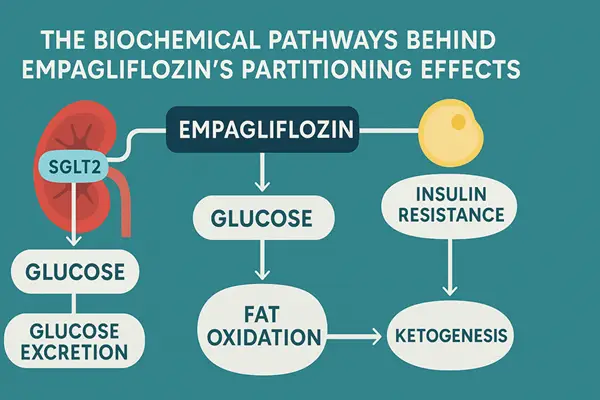Empagliflozin is best known as an SGLT2 inhibitor prescribed to manage type 2 diabetes by helping the body excrete excess glucose through urine. But in recent years, researchers have uncovered another fascinating aspect of this medication: its ability to act as a metabolic partitioning aid. Beyond lowering blood sugar, empagliflozin influences how the body allocates energy, shifting the balance between fat storage and fat utilisation.
Here, we explore the biochemical pathways behind these effects and why they are sparking interest in both clinical and research settings.
1. How Empagliflozin Alters Glucose Handling
Empagliflozin works by blocking sodium-glucose co-transporter 2 (SGLT2) in the kidneys. This transporter is responsible for reabsorbing most of the glucose filtered by the kidneys back into the bloodstream. By inhibiting SGLT2, empagliflozin allows more glucose to be excreted in urine, lowering blood sugar levels.
But this effect has a secondary consequence: it creates a mild caloric deficit because the body loses energy with every gram of glucose expelled. This forced energy loss triggers metabolic adaptations, encouraging the body to tap into fat stores for fuel.
2. Shifting the Body’s Energy Substrate Preference
Under normal conditions, the body prioritises glucose as its primary energy source. By reducing available glucose, empagliflozin indirectly nudges the body towards increased fat oxidation. This shift is partly regulated by changes in the hormone glucagon, which rises slightly as insulin levels fall due to lower glucose.
Glucagon stimulates the liver to release stored energy and promotes lipolysis, the breakdown of fats into fatty acids for energy use. Over time, this can promote a leaner body composition by favouring fat burning over fat storage.
3. Activation of Ketogenesis
With glucose availability reduced, another metabolic pathway comes into play: ketogenesis. Empagliflozin has been shown to increase circulating ketone bodies modestly, especially in individuals who follow lower-carbohydrate diets or who are in a calorie deficit.
Ketones act as an alternative fuel source for muscles, the brain, and other organs. By promoting mild ketosis, empagliflozin may enhance metabolic flexibility, allowing the body to switch more easily between fuel sources. This not only supports fat loss but can also improve endurance and energy stability throughout the day.
4. Reduction in Insulin Resistance
High insulin levels encourage the body to store fat and inhibit fat breakdown. By promoting urinary glucose loss and improving blood sugar control, empagliflozin helps lower both fasting and post-meal insulin levels. This reduction in insulin encourages fat mobilisation and may improve the hormone’s sensitivity, allowing cells to use nutrients more efficiently.
In clinical studies, patients using empagliflozin often show reductions in visceral fat, the deeper, more harmful fat surrounding organs, which is closely linked to insulin resistance and metabolic risk.
5. Why these pathways matter for more than diabetes
Although empagliflozin is primarily prescribed for blood sugar management, its impact on fat oxidation, ketone production, and energy allocation has broader implications. Researchers are studying whether these effects could benefit people with metabolic syndrome, obesity, or even athletes seeking improved energy efficiency during training.
By reshaping how the body uses fuel, empagliflozin demonstrates that medications can influence far more than a single biomarker. Its biochemical effects highlight a growing interest in therapies that not only treat conditions but also optimise energy use and body composition.
Should you consider empagliflozin for its partitioning effects?
While the metabolic benefits of empagliflozin are promising, this medication is not a shortcut for weight management or performance enhancement. It is a prescription drug with potential side effects and must be used under medical supervision.
However, its role as a partitioning aid is opening doors for future research into how targeted therapies can help rebalance the body’s energy systems, with potential applications beyond traditional diabetes care.


